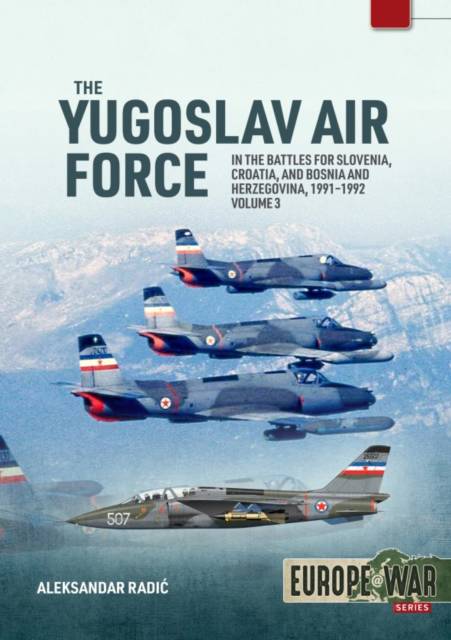
- Retrait gratuit dans votre magasin Club
- 7.000.000 titres dans notre catalogue
- Payer en toute sécurité
- Toujours un magasin près de chez vous
- Retrait gratuit dans votre magasin Club
- 7.000.0000 titres dans notre catalogue
- Payer en toute sécurité
- Toujours un magasin près de chez vous
The Yugoslav Air Force Volume 3
In the Battles for Slovenia, Croatia, and Bosnia and Herzegovina, 1991-1992
Aleksandar Radic
27,95 €
+ 55 points
Description
Following years of growing tensions and months of small-scale armed conflict, in summer 1991 the crisis in the former Socialist Federative Republic of Jugoslavia (SFRJ) culminated in a war. Following a brief conflict in which the Federal forces were forced to withdraw from Slovenia, the focus of the conflict moved to Croatia. Feeling threatened by Serbian nationalism, the new government in Zagreb, the capitol of Croatia, was determined to lead the country into independence. Convinced their duty was to safeguard the survival of the multi-ethnic country, and aiming to prevent this republic from breaking up the federation, generals in charge of the armed forces were determined to launch a military intervention to thwart Croatia's secession. However, Serbian political leaders were supporting a secession of Serbian nationalists in Croatia: with their- and the clandestine support from within the ranks of the Jugoslav National Army (JNA), the Serbs in Croatia brought nearly a third of the country under their control, in turn adding fuel to fire of Croatian nationalists.
As described in the Volume 2 of this mini-series - the war in that country erupted on 14 September 1991, when Croatia went into a strategic offensive and imposed a blockade of all military bases of the Jugoslav National Army (JNA). Like the JNA, the Jugoslav Air Force and Air Defence Force (RV i PVO) considered itself a 'peacekeeper' therefore, and exactly like in northern- and central Croatia, in north-western- and southern Croatia it went into action through providing protection and close air support for JNA forces blocked by Croats inside their barracks.
However, only two days later, the JNA launched its own, full-blown strategic offensive, aiming to totally defeat the government in Zagreb. Supported by Serbian and Montenegrin paramilitary forces, the JNA and the RV i PVO proved more successful while advancing into the central and southern Croatia, than in the north and east. However, their offensive also proved a disaster for the Federals: it not only caused mass desertions, but ended with involved forces becoming bogged down in month-long battles for Karlovac, Zadar, and Sibenik. Worse yet, widespread atrocities against civilians, and pillaging of the areas around the historic town of Dubrovnik, as well as repeated and massive air strikes and artillery barrages on the latter have not only demolished the reputation of the JNA and the RV i PVO, but also crystallised the federal forces as an aggressor. Ultimately, this forced top commanders of Federal forces to accept the Serbian political war aims - which, ultimately, led to both the JNA and the RV i PVO beginning the process of conversion into the Serbian armed forces.
Richly illustrated with authentic photography and custom-made colour illustrations, the Volume 3 of this mini-series is covering the RV i PVO's operations over north-western- and southern Croatia, through August, September, and early November 1991.
As described in the Volume 2 of this mini-series - the war in that country erupted on 14 September 1991, when Croatia went into a strategic offensive and imposed a blockade of all military bases of the Jugoslav National Army (JNA). Like the JNA, the Jugoslav Air Force and Air Defence Force (RV i PVO) considered itself a 'peacekeeper' therefore, and exactly like in northern- and central Croatia, in north-western- and southern Croatia it went into action through providing protection and close air support for JNA forces blocked by Croats inside their barracks.
However, only two days later, the JNA launched its own, full-blown strategic offensive, aiming to totally defeat the government in Zagreb. Supported by Serbian and Montenegrin paramilitary forces, the JNA and the RV i PVO proved more successful while advancing into the central and southern Croatia, than in the north and east. However, their offensive also proved a disaster for the Federals: it not only caused mass desertions, but ended with involved forces becoming bogged down in month-long battles for Karlovac, Zadar, and Sibenik. Worse yet, widespread atrocities against civilians, and pillaging of the areas around the historic town of Dubrovnik, as well as repeated and massive air strikes and artillery barrages on the latter have not only demolished the reputation of the JNA and the RV i PVO, but also crystallised the federal forces as an aggressor. Ultimately, this forced top commanders of Federal forces to accept the Serbian political war aims - which, ultimately, led to both the JNA and the RV i PVO beginning the process of conversion into the Serbian armed forces.
Richly illustrated with authentic photography and custom-made colour illustrations, the Volume 3 of this mini-series is covering the RV i PVO's operations over north-western- and southern Croatia, through August, September, and early November 1991.
Spécifications
Parties prenantes
- Auteur(s) :
- Editeur:
Contenu
- Nombre de pages :
- 80
- Langue:
- Anglais
- Collection :
Caractéristiques
- EAN:
- 9781804518670
- Date de parution :
- 15-11-25
- Format:
- Livre broché
- Format numérique:
- Trade paperback (VS)
- Dimensions :
- 211 mm x 297 mm

Les avis
Nous publions uniquement les avis qui respectent les conditions requises. Consultez nos conditions pour les avis.






